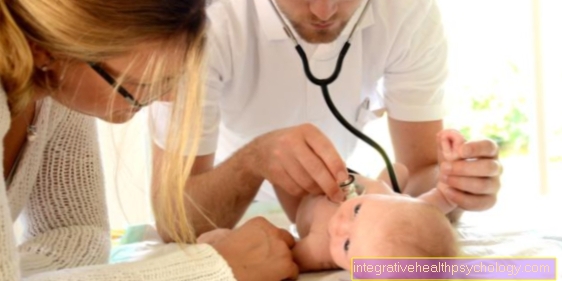Water head
Synonyms
Vernacular = "head of water"
Plural = Hydrocephaly
Engl. = hydrocephalus
definition
Under a head of water (Hydrocephalus) one understands an increasing expansion of the CSF spaces (Ventricle) of the brain as a result of impaired circulation, absorption or production of the nerve water (Cerebrospinal fluid).

Frequency distribution
50% of all patients affected by the disease "hydrocephalus / water head" are infants and toddlers, the other half is formed by adults, whereby especially people over 60 years of age suffer from water head.
Assuming that, 25% of hydrocephalus cases are congenital or combined with a defect in the neural tube (stage of development of the central nervous system).
The incidence of these congenital forms (congenital hydrocephalus) is 1 to 4 per 1000 births.
Symptoms in adults
The symptoms of a water head in adults are caused by the increase in pressure in the skull. In adults, the skull bone forms a closed space that cannot be expanded.
The overproduction of brain water or an obstacle to drainage causes an increase in pressure on the brain tissue. The cavities in the brain, which contain the cerebrospinal fluid, expand and press on sensitive structures on the brain. This increase in pressure leads to failures similar to those of strokes.
Those affected complain of impaired vision, headaches and dizziness. Movement disorders such as gait instability are also known. In some cases changes in personality and memory disorders are also possible.
If diagnosed late, entrapment of the brain is also possible. Those affected pass out because parts of the brain are pinched and their function is impaired. This particularly includes the brain stem, which contains the circulatory center and the respiratory center. This condition is acutely life-threatening.
You can find detailed information on this topic at: Symptoms of a water head
Diagnosis of a water head

In order to be able to make the diagnosis “water head”, first and foremost the questioning of the medical history (anamnese) necessary. This is followed by a neurological examination (see also: Neurology), in which special attention is paid to the typical symptoms of a water head.
Furthermore, imaging methods are used, namely a computed tomogram (cCT) or a head MRI (cMRT, nuclear spin). Except in the emergency situation, however, a head MRI is usually preferred to detect a water head.
The recording of brain waves by means of an EEG (electroencephalogram) can also provide important information about the presence of hydrocephalus.
Further diagnostic options include a pressure measurement of the liquor or a scintigraphy. As a rule, the former is no longer used for diagnostics, the latter serves to reveal a disturbed absorption of the liquor with the help of radioactive substances.
The head circumference should be measured regularly in order to detect an increase in volume of the skull and thus a water head in good time. To clarify an existing ventricular enlargement, an ultrasound examination is carried out first (Sonography) of the head and the next measure is a CT or MRI of the head. In addition, a reflection of the fundus is helpful to discover a bleeding or congestive papilla as an indication of a water head. Magnetic resonance imaging (MRI) can also be used to detect hydrocephalus.
Here you get to all topics of Diagnosis
Forecast of a water head
An untreated water head in early childhood is fatal in more than 50% of cases, while the other half of small hydrocephalus patients usually have a disability.
With timely therapy, however, i.e. the creation of a shunt, the lethality of a water head drops to below 10% and over 66% of the patients retain neither a physical nor a mental disability. In the rest of those suffering from hydrocephalus, however, there are partial performance disorders or behavioral problems.
Patients with a water head usually also have increased intracranial pressure. What can be done about it and what is the prognosis?: Increased intracranial pressure - Signs, causes and therapy
What is the life expectancy?
The life expectancy of water head patients depends on various factors. The time of diagnosis and the cause play a particularly important role.
If there is no diagnosis, a head of water can be acutely life-threatening, as the increased pressure causes vital areas of the brain to become trapped. In the case of a drainage disorder, for example due to a tumor, an operation can mean permanent cure and life expectancy does not differ from the life expectancy of other people.
With a shunt system, which usually has to be left in place, in most cases a reduction in life expectancy is also not to be expected. However, since in some cases the tube becomes infected with involvement of the brain and meninges, there is a risk of death in acute cases.
So life expectancy depends particularly on how quickly the diagnosis of water on the head is made.Without treatment, the water head can be fatal, while with early treatment, life expectancy is significantly longer. Depending on the cause of the water head, however, the underlying disease can limit life expectancy.
What spiritual development can be expected?
The time of diagnosis is also decisive for mental development. Permanently increased pressure on areas of the brain can lead to significant restrictions. Furthermore, the cause of the water head is also decisive.
If you have a head of water due to a brain malformation, you can almost always expect a significant mental handicap. Even in children who develop a head of water in the womb, mental impairments are to be expected, since treatment is not yet possible during pregnancy.
Basically, the underlying disease is more decisive for the child's development than the water on the head itself.
Predicting the limitations is usually not possible immediately after diagnosis. Many children are able to lead an independent life through appropriate therapy. This only becomes apparent over many years and can be assessed on the basis of certain development milestones.
With appropriate treatment, no further damage is to be expected from an already known water head.
Read more on the subject at: Head of water in the baby
Therapy options
Without treatment, a head of water can be fatal. The therapy depends on the cause of the water head.
In the case of a drainage disorder, an attempt is made to remove the cause surgically. This could be a tumor or a lump in the drainage area.
There are also various surgical options for treating a water head. One variant is a bypass route that is inserted into the cavity system of the brain with an endoscope. This can also only be used if the drainage paths are closed.
The second option is to create a shunt. This is a tube system that drains the brain water directly into the abdomen or the heart. This can also be used in case of overproduction of brain water.
Cavity drainage is also suitable as a short-term solution. In the case of acute drainage disorders, brain water is removed. However, this is only a short-term emergency solution.
Medicines to reduce cerebral water production are not yet available.
This article might interest you: Therapy for a water head
Shunt in a water head
The shunt is an operative option for long-term treatment of a water head that is caused by an overproduction or an incorrect intake of cerebral water. Since there is too much cerebrospinal fluid in the ventricular system of the brain in a water head, strong pressure is exerted on the brain.
This pressure can be reduced through the artificial extraction of brain water.
The shunt consists of several tubes and valves.
A tube is inserted into the cavity system of the brain. There is a valve at the end of the hose to regulate the flow rate. Without this valve, all of the cerebral water would flow away, which is, however, necessary for brain function.
Another tube is in the abdomen or in the heart. This is where the brain water that is produced too much is diverted and absorbed by the body.
Various complications are possible when creating a shunt. A possible complication is a defective valve, which can lead to too little or too much drainage of cerebral fluid. Infections from the exogenous material are also possible. With such an infection, the shunt must be removed.
Is a head of water curable?
A head of water can be curable or incurable depending on the cause. In the case of a drainage disorder, a complete cure may be possible through an operation.
In other cases, however, it is an overproduction or poor recovery of cerebral water. In many cases this is not permanently curable.
This can be remedied by a shunt. Those affected have to have regular checkups and usually wear this shunt system for their entire life. The long-term effects can be limited in this way or completely prevented, but this is not a complete cure.
Head of water with spina bifida
Some children with a water head also have spina bifida. This is a malformation of the spinal cord and spinal canal. This is also called an open back. In most cases, this disease leads to walking difficulties.
However, these children often have a good prognosis with regard to their intellectual development, as they are controlled much more closely than other children. In some special centers, surgical treatment of the spina bifida in the womb is already possible, which in some cases preserves the ability to walk.
This article might also interest you: Spina bifida
Head of water through creatine- a myth?
Pure creatine is an endogenous substance made up of amino acids and serves the body as an energy reserve. The breakdown substance creatinine is excreted through the kidneys.
By additionally taking creatine to build muscle, some side effects such as nausea, diarrhea and water retention are possible.
However, one of these side effects is not that the risk of a water head increases. When taking creatine, make sure you drink enough fluids to keep your water and salt levels in balance.
You might also be interested in: Creatine
Anatomical excursus
The liquor system, which is affected by changes in hydrocephalus / water head, is divided into internal and external liquor spaces.
The inner liquor spaces are formed by the ventricles, which can be imagined as a communicating system of extensions inside the brain. There are a total of 4 ventricles, namely 2 lateral ventricles (I. and II. Ventricles), the centrally located III. Ventricle and the fourth ventricle, which is located in front of the cerebellum. Get connected III. and IV. ventricle over the aqueduct (Aqueductus cerebri).
The outer cerebrospinal fluid is a space between the leaves of the soft meninges (Pia mater and Arachnoid), which is called the subarachnoid space. This surrounds the brain and the spinal cord and has larger extensions at certain points, the so-called cisterns.
There are connections between the inner and outer spaces of the liquor, which enable a constant circulation of the liquor through these spaces.
The path of circulation begins in the lateral ventricle and continues in the III. and IV. ventricle and from there enters the outer liquor spaces of the brain and spinal cord. From there the cerebrospinal fluid flows through venous plexuses (Venous plexus) or protrusions of the meninges protruding into veins (Arachnoid villi) into the venous and lymphatic systems.
The task of liquor production is taken over by convolutes of vascular villi, which are located in the walls of the lateral and III. and IV. ventricle are located. These vascular villi are referred to as Choroid plexus, which probably forms the liquor through secretion or filtration, although the ultimate pathway has not yet been clarified.
The amount of cerebrospinal fluid circulating in the cerebrospinal fluid spaces is around 50 ml in children and around 150 ml in adults.
Please also read our article on this Cerebral ventricle
Summary
A hydrocephalus / hydrocephalus refers to an expansion of the ventricles of the brain in which the nerve water, the Cerebrospinal fluid, is located. Depending on the cause, a hydrocephalus is classified more closely; Either the outflow, the production or the absorption of the liquor may be abnormally changed, so that symptoms suggestive of hydrocephalus such as headache, nausea, psychological changes, impaired consciousness or, in children, an increase in head circumference occur.
To treat hydrocephalus, a so-called shunt is usually applied, with the help of which the liquor is drained and thus the congestion of the liquor in the ventricles is eliminated.
Further on the topic:
- Symptoms of a water head
- Therapy of the water head





























